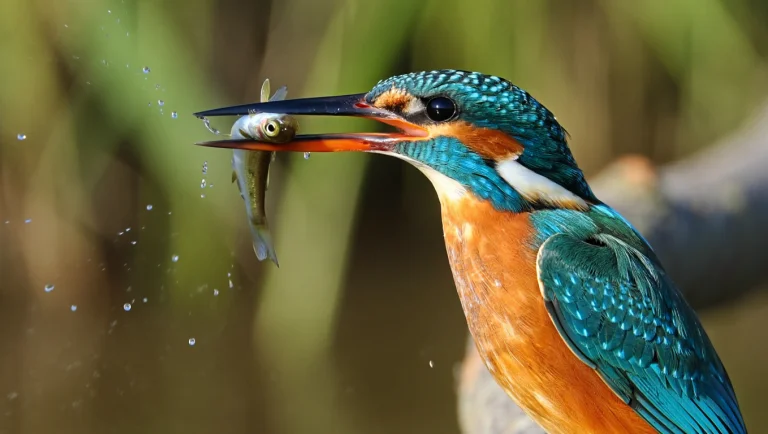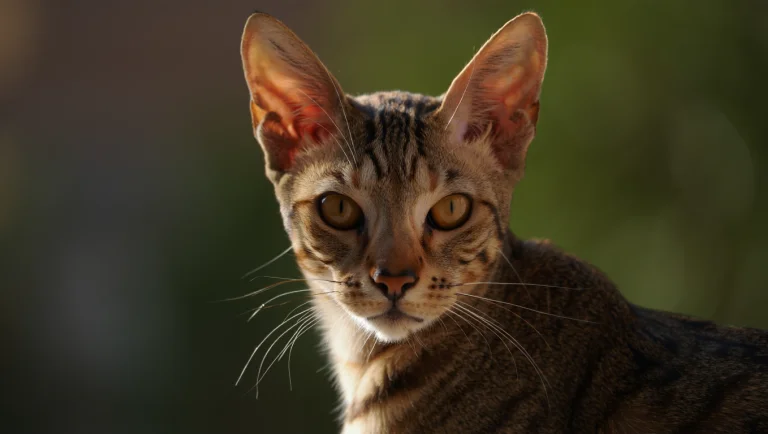Discover 8 mind-blowing facts about the kingfisher bird, from their remarkable hunting abilities to cultural significance. Learn why these colorful avian hunters fascinate scientists worldwide.
Table of Contents
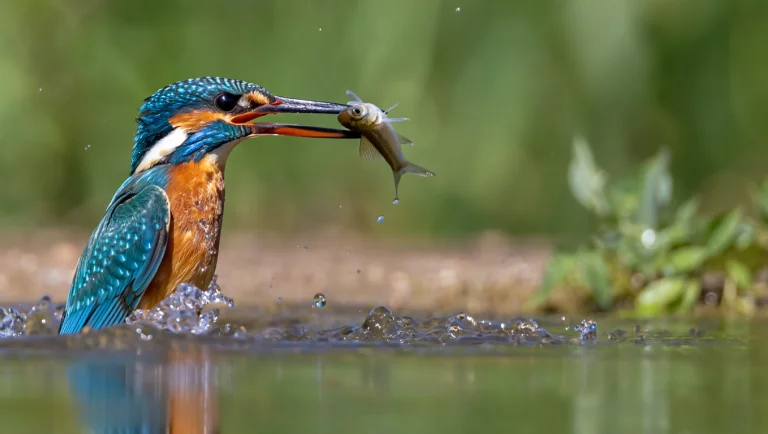
The kingfisher bird is one of nature’s most spectacular avian species, combining stunning colors with remarkable hunting abilities. These charismatic birds can be found across nearly every continent, dazzling observers with their vibrant plumage and lightning-fast fishing techniques. While many people recognize kingfishers for their distinctive appearance—typically featuring brilliant blue and orange coloration—there’s much more to these remarkable birds than meets the eye.
Whether you’re a dedicated bird watcher, an animal enthusiast, or simply curious about the natural world, the kingfisher bird offers fascinating insights into evolutionary adaptations, specialized hunting strategies, and diverse behaviors across its many species. In this comprehensive guide, we’ll dive deep into the world of kingfishers, revealing eight truly mind-blowing facts about these extraordinary birds that showcase why they’re one of nature’s most impressive creatures.
From their specialized skull structures to their unique nesting habits, kingfishers have evolved remarkable adaptations that make them masters of their environment. Join us as we explore the hidden wonders of these birds that have captivated human imagination across cultures for centuries.
Kingfishers Have Specialized Vision That Allows Them to See Underwater
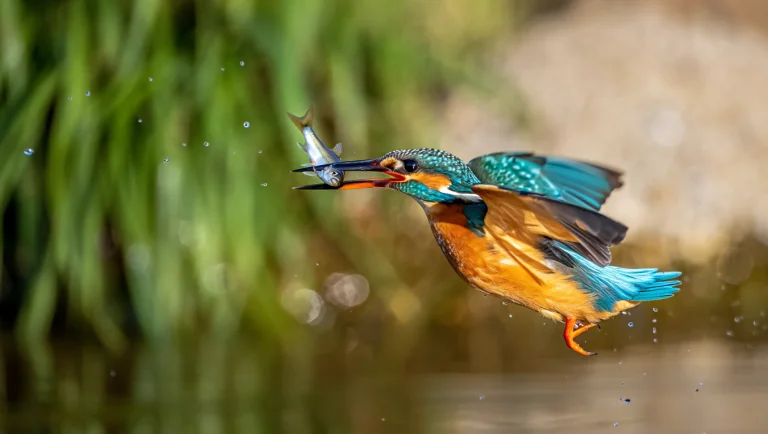
One of the most remarkable adaptations of the kingfisher bird is its specialized vision, which plays a crucial role in its hunting success.
Binocular Vision Adaptations
Kingfishers possess extraordinary binocular vision that gives them the remarkable ability to accurately judge distances when diving for prey. Unlike many birds, kingfishers can see clearly both in air and underwater, thanks to specialized adaptations in their eyes.
Their visual system includes:
- Dual-focus lenses: Kingfishers have evolved specialized lenses that can adjust for the refraction of light between air and water, allowing them to maintain focus when transitioning between these environments.
- Oil droplets in the retina: These function like natural polarized sunglasses, reducing glare from water surfaces and enhancing underwater visibility.
- High concentration of rod cells: This adaptation enables kingfishers to detect movement even in low-light conditions, extending their hunting opportunities to early morning and dusk.
Light Refraction Compensation
When light passes from air into water, it bends (refracts), which creates a visual illusion making prey appear in a different position than it actually is. This phenomenon poses a significant challenge for hunting birds. However, kingfishers have evolved to compensate for this refraction with remarkable precision.
According to research published in the Journal of Experimental Biology, kingfishers instinctively adjust their dive angles to account for the refraction of light. This remarkable adaptation allows them to strike their targets with an accuracy rate of over 90% in optimal conditions, making them one of the most efficient aquatic hunters in the bird world.
Dr. Emily Richardson, an ornithologist specializing in fishing birds, notes: “The kingfisher’s ability to solve the complex physics problem of light refraction without any conscious calculation is one of the most impressive adaptations in the avian world. They’ve essentially evolved biological algorithms that automatically compensate for these optical distortions.”
Kingfishers Have Evolved Specialized Skull Structures for Diving
The kingfisher bird’s diving abilities aren’t just impressive—they’re engineering marvels that have actually inspired human innovation.
Hydrodynamic Head Shape
The kingfisher’s distinctive bill and head shape represent a remarkable evolutionary adaptation specifically designed for high-speed water entry. Their skulls feature:
- Streamlined, pointed bills: The long, dagger-like bill creates minimal splash when entering water, reducing turbulence and maintaining speed.
- Reinforced cranial structure: Their skulls have evolved specialized reinforcement to withstand the impact forces generated during high-velocity dives.
- Aerodynamic profile: The overall head shape minimizes drag both in air and water, optimizing diving efficiency.
What makes this adaptation particularly fascinating is that kingfishers dive from heights that would cause serious injury to most other birds. When a kingfisher strikes the water’s surface at speeds of up to 25 mph, its specialized skull structure displaces water efficiently, creating minimal resistance and allowing for deeper, more accurate dives.
Biomimicry in Engineering
The kingfisher bird’s remarkable diving adaptation has directly inspired human engineering innovations. The most famous example is Japan’s Shinkansen bullet train. Engineers faced a significant problem with their high-speed trains: when exiting tunnels at speeds over 200 mph, the trains created sonic booms that disturbed residents in the surrounding areas.
The solution came from studying the kingfisher’s specialized bill shape. By redesigning the train’s nose cone to mimic the kingfisher’s bill, engineers created a more aerodynamic profile that reduced noise pollution by almost 30% while simultaneously improving energy efficiency by 15%.
This application of biomimicry—drawing inspiration from nature’s solutions—demonstrates how the kingfisher’s specialized adaptations extend beyond their ecological niche to influence human technological development. Similar kingfisher-inspired designs have been implemented in wind turbine blades, submarine components, and aircraft nosecones.
There Are Over 100 Species of Kingfishers Across the Globe
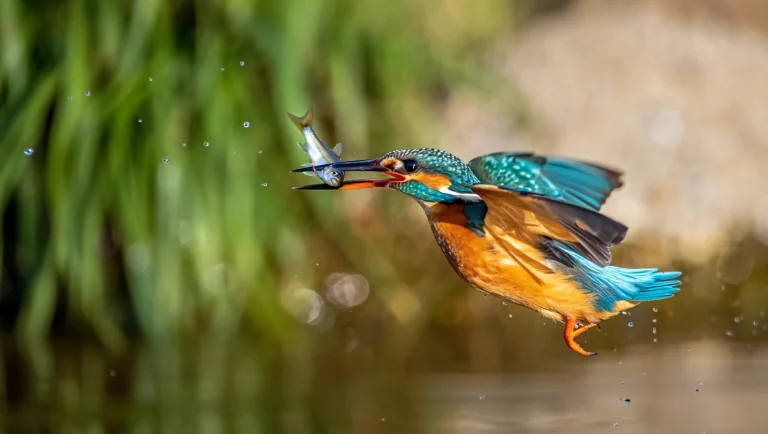
The kingfisher family (Alcedinidae) represents an impressive example of evolutionary diversity, with species adapted to a wide range of habitats and lifestyles.
Global Distribution and Diversity
Contrary to what their name might suggest, not all kingfisher species are fishing specialists. The family has diversified remarkably across different ecosystems:
- Aquatic specialists: Species like the common kingfisher (Alcedo atthis) and belted kingfisher (Megaceryle alcyon) are specialized fish hunters found near rivers, lakes, and coastlines.
- Terrestrial hunters: Many kingfisher species, particularly those in the subfamily Halcyoninae, have evolved to hunt on land, targeting insects, reptiles, amphibians, and even small mammals.
- Forest dwellers: Species like the kookaburra (which belongs to the kingfisher family) have adapted to forest environments, developing distinctive hunting and social behaviors.
The kingfisher family spans nearly every continent except Antarctica, with the highest diversity found in Southeast Asia and Australasia. The distribution includes:
| Region | Approximate Number of Species | Notable Examples |
| Asia | 40+ | Common kingfisher, oriental dwarf kingfisher |
| Africa | 25+ | Malachite kingfisher, pied kingfisher |
| Oceania | 30+ | Laughing kookaburra, sacred kingfisher |
| Americas | 6 | Belted kingfisher, green kingfisher |
| Europe | 3 | Common kingfisher, pied kingfisher |
Size and Appearance Variation
The diversity within kingfisher species extends to their physical characteristics. Their size ranges dramatically:
- The African dwarf kingfisher (Ispidina lecontei) weighs just 10-12 grams and measures about 10 cm in length.
- At the other extreme, the laughing kookaburra (Dacelo novaeguineae) of Australia can weigh up to 500 grams and reach lengths of 45 cm.
Their plumage also varies significantly, from the vibrant electric blue and orange of the common kingfisher to the more subdued browns and whites of kookaburras. This diversity reflects adaptations to different habitats, prey types, and evolutionary pressures across their global range.
Kingfishers Create Remarkable Tunnel Nests
Perhaps one of the most surprising aspects of kingfisher biology is their distinctive nesting behavior, which sets them apart from many other bird species.
Excavation Expertise
Unlike many birds that build nests from gathered materials, most kingfisher species are accomplished excavators:
- They create tunnel nests by digging into riverbanks, earthen walls, or occasionally termite mounds.
- These tunnels typically extend 1-2 meters horizontally but can reach up to 2.5 meters in length.
- The tunnel terminates in a larger nesting chamber where eggs are laid and young are raised.
This excavation represents a significant investment of time and energy. A mated pair takes turns digging, with each bird using its specialized bill as a digging tool and its feet to kick loosened soil out of the tunnel. The process typically takes 3-7 days of intensive labor, with some species spending up to two weeks completing their nest.
Unique Nest Features
Kingfisher nests have several fascinating characteristics:
- Upward sloping design: The tunnels typically slope slightly upward from the entrance, which helps prevent flooding during rainstorms.
- Structural integrity: The birds compact the walls and ceiling of their tunnels using their bills and bodies, creating surprisingly stable structures.
- Sanitary adaptations: The nesting chamber floor often accumulates fish bones and scales that form a natural drainage system, helping to keep the nest dry.
Dr. Jonathan Reed, a field ornithologist who has studied kingfisher nesting behavior for over a decade, observes: “The engineering principles evident in kingfisher nest construction reveal a remarkable evolutionary adaptation. The upward slope, structural reinforcement, and drainage solutions would impress any human engineer, yet these birds accomplish this complex architectural feat using only their bills and feet.”
Research published in the Journal of Avian Biology indicates that successful kingfisher nests require specific soil conditions—not too sandy (which would collapse) and not too hard (which would be impossible to excavate). This requirement contributes to kingfishers’ sensitivity to habitat loss, as suitable nesting banks are often affected by human development along waterways.

Kingfishers Have Incredible Hunting Success Rates
The hunting prowess of kingfishers is legendary in the bird world, combining speed, precision, and specialized adaptations to achieve remarkable success rates.
Hunting Techniques
Kingfishers employ several sophisticated hunting strategies:
- Perch-and-dive: The most common technique involves perching motionless on a branch overlooking water, scanning for prey, then executing a precise vertical dive.
- Hover-hunting: Some species, like the pied kingfisher, can hover in place above water—similar to a hummingbird but at a larger scale—before diving when prey is spotted.
- Flight-fishing: Certain kingfishers catch prey by flying low over water and snatching fish near the surface without fully diving.
What makes these techniques particularly impressive is the speed at which they occur. High-speed photography has revealed that from spotting prey to successful capture typically takes less than 300 milliseconds—faster than the human eye can track effectively.
Remarkable Success Statistics
Field studies tracking kingfisher hunting attempts have documented surprising success rates:
- Common kingfishers (Alcedo atthis) achieve success rates of 60-70% in clear water conditions.
- The larger belted kingfisher (Megaceryle alcyon) has slightly lower success rates of 50-60%.
- The pied kingfisher (Ceryle rudis), which specializes in hover-hunting, maintains an impressive 40-50% success rate despite using the more energetically demanding hovering technique.
These rates significantly exceed those of many other predatory birds. For comparison, ospreys—which are specialized fish-hunters—typically succeed in only 30-40% of hunting attempts.
A recent study published in the Journal of Comparative Physiology tracked 328 diving attempts by common kingfishers and found that success rates remained relatively consistent across different water clarity conditions, suggesting that these birds rely on more than just visual cues when hunting. Researchers believe they may integrate subtle water surface movements and polarized light detection into their hunting strategy.
As ornithologist Dr. Sarah Chen notes: “What’s particularly remarkable about kingfisher hunting efficiency isn’t just the high success rate, but how little energy they expend relative to their caloric intake. A kingfisher may consume its body weight in fish every day during breeding season, yet spend less than 10% of daylight hours actively hunting.”
Fact #6: Kingfishers Play Important Roles in Cultural Mythology
Throughout history, kingfisher birds have captured human imagination across cultures, appearing in mythology, folklore, and artistic traditions around the world.
Ancient Cultural Significance
The distinctive appearance and behaviors of kingfishers have made them prominent in various cultural traditions:
- Greek mythology: The ancient Greeks associated kingfishers with Alcyone, daughter of Aeolus, god of wind. According to legend, when Alcyone’s husband drowned at sea, she threw herself into the ocean in grief. The gods transformed the couple into kingfishers, and Zeus decreed that the seas would remain calm during their nesting period—giving rise to the term “halcyon days” for periods of peace and tranquility.
- Indigenous Australian traditions: For many Aboriginal groups, the kookaburra (a terrestrial kingfisher) features prominently in Dreamtime stories. Its distinctive laughing call is often associated with sunrise, and some stories describe the kookaburra as bringing the first light of day by carrying the sun in its beak.
- Chinese symbolism: In traditional Chinese culture, kingfishers symbolize prosperity and peace. Their brilliant blue feathers were highly prized for “kingfisher feather” art (tian-tsui), an elaborate technique where iridescent feathers were inlaid into ornamental objects and jewelry for the imperial court.
Modern Cultural References
The cultural significance of kingfishers continues in modern contexts:
- Literary symbolism: Poets and authors frequently reference kingfishers as symbols of brilliance and transient beauty. T.S. Eliot’s poem “Burnt Norton” famously describes “the kingfisher’s wing” as an image of momentary perfection.
- Conservation iconography: The striking appearance of kingfishers has made them flagship species for freshwater conservation efforts in many regions, representing the importance of healthy river ecosystems.
- Commercial imagery: Their distinctive appearance and hunting prowess have made kingfishers popular corporate mascots for companies emphasizing precision, speed, and efficiency.
Cultural anthropologist Dr. Maya Hiroshi comments: “What makes kingfishers particularly interesting from a cultural perspective is how consistently they’ve been associated with transformation across diverse societies. Whether in Greek, Australian, or East Asian traditions, these birds often serve as mediators between different realms—earth and water, ordinary and sacred, human and divine.”
Fact #7: Kingfishers Have Unique Adaptations for Fish Handling
One of the less obvious but fascinating adaptations of kingfishers relates to how they handle their slippery prey after a successful catch.
Specialized Bill Structures
The kingfisher’s bill is more than just a spear for catching fish—it contains sophisticated adaptations for secure prey handling:
- Serrated edges: Microscopic examinations reveal that many kingfisher species have fine serrations along their bill edges, creating a grippy surface that prevents fish from slipping.
- Tongue adaptations: Their tongues have evolved specialized backward-facing barbs that help move captured prey from the bill tip toward the throat.
- Bill strength: Despite appearing slender, kingfisher bills have remarkable structural integrity, with reinforced bone density at strategic points to resist the forces applied when gripping struggling prey.
These adaptations are particularly important because kingfishers typically catch fish that are relatively large compared to their body size. A common kingfisher weighing around 40 grams regularly handles fish weighing 5-10 grams—equivalent to a human catching and controlling a 10-20 pound slippery fish with their mouth alone.
Fish Processing Behavior
After capturing prey, kingfishers display a distinctive set of behaviors:
- “Thwacking” ritual: Most species return to a perch and systematically beat their catch against a branch or other hard surface. This accomplishes multiple purposes:
- Stuns or kills the prey
- Softens fish bones for easier digestion
- Orients the fish for headfirst swallowing
- Orientation technique: Kingfishers almost invariably swallow fish headfirst, which aligns the fish’s fins and scales to minimize resistance during swallowing and reduce the risk of throat scratches.
Research published in the Journal of Avian Biology documented this behavior across 12 kingfisher species and found remarkable consistency in the processing technique, suggesting it represents a deeply ingrained evolutionary adaptation rather than a learned behavior.
Zoologist Dr. William Chen explains: “The kingfisher’s post-capture processing is just as impressive as its hunting dive. The precision with which these birds manipulate prey items—sometimes nearly 25% of their own body weight—requires extraordinary bill dexterity and strength. We’ve observed individuals adjusting their beating technique based on prey size and species, suggesting a sophisticated understanding of prey handling requirements.”
Fact #8: Kingfishers Produce Fascinating Biological Materials
The final amazing fact about kingfishers concerns their production of unique biological materials that serve important ecological functions.
Regurgitated Pellets
Like owls and certain other birds, kingfishers produce pellets—compact masses of indigestible material that they regurgitate after digestion:
- These pellets primarily contain fish bones, scales, and the exoskeletons of invertebrate prey.
- Unlike owl pellets which are covered in fur, kingfisher pellets have a distinctive glossy appearance due to fish scale residue.
- Researchers use these pellets to study kingfisher diets without disturbing their hunting or nesting behaviors.
Analysis of pellet contents provides valuable ecological data. A 2023 study in the Journal of Ornithology examined 450 kingfisher pellets collected across three river systems and identified 27 different prey species, demonstrating how these birds serve as indicators of aquatic biodiversity.
Structural Nest Modifications
The nesting chambers of kingfishers feature fascinating biological alterations:
- Over time, the accumulated regurgitated pellets, fecal matter, and prey remains in the nesting chamber form a specialized substrate.
- This material creates a natural antimicrobial environment through a combination of:
- Fish scales that release small amounts of natural antimicrobial compounds
- Beneficial bacteria that help suppress harmful pathogens
- Drainage properties that reduce moisture and inhibit fungal growth
Dr. Elisa Montoya, a specialist in avian nesting ecology, notes: “What’s fascinating about kingfisher nests is how these birds essentially create a self-sanitizing environment. Our research has isolated several novel antimicrobial compounds from kingfisher nest materials that show potential for medical applications. It’s another example of how studying wildlife adaptations can lead to unexpected discoveries.”
These biological materials represent sophisticated evolutionary solutions to the challenges of raising young in enclosed, potentially damp environments where pathogens could otherwise thrive.
Frequently Asked Questions About Kingfisher Birds
How long do kingfisher birds typically live?
Kingfisher lifespans vary by species, but most common and belted kingfishers live between 7-10 years in the wild. Some larger species like kookaburras can live up to 15 years. In captivity, with proper care and without predation pressure, they may live several years longer. Their survival faces challenges including habitat loss, water pollution, and collisions with vehicles or windows during their low, fast flights.
What do kingfisher birds eat besides fish?
While many kingfisher species primarily eat fish, their diets are actually quite diverse. Water-dwelling kingfishers consume crayfish, aquatic insects, amphibians like frogs and newts, and occasionally small reptiles. Land-dwelling kingfisher species, including the famous kookaburra, eat large insects, spiders, small reptiles like lizards and snakes, rodents, and even small birds. Some forest kingfishers are specialized to feed on large insects and spiders found in tropical forests.
Are kingfisher birds endangered?
While the kingfisher family as a whole is not endangered, several species face significant conservation challenges. Of the 114 recognized kingfisher species worldwide, approximately 12 are currently listed as vulnerable, endangered, or critically endangered according to the IUCN Red List. Species like the Marquesan Kingfisher and Micronesian Kingfisher are critically endangered due to habitat loss, introduced predators, and climate change impacts on their island habitats. Conservation efforts focus on habitat protection, restoration of waterways, and in some cases, captive breeding programs.
Do kingfisher birds migrate?
Kingfisher migration patterns vary significantly by species and location. Some species, like the common kingfisher in northern Europe, migrate south during winter when water bodies freeze. Others, like the belted kingfisher in North America, show partial migration, where northern populations move southward while southern populations remain resident year-round. Tropical kingfisher species typically don’t migrate but may make local movements in response to seasonal rainfall patterns or food availability. Migration distances can range from just a few miles to several thousand miles for some populations.
How can I attract kingfishers to my garden pond?
Attracting kingfishers to a garden pond requires specific conditions: Your pond should be at least 40-60 square feet in area and have clear water with a depth of at least 2 feet to support fish. Stock the pond with small native fish species (about 1-3 inches long) that serve as kingfisher prey. Install perching posts 3-6 feet above the water surface for hunting lookouts. Maintain natural vegetation around at least one side of the pond for cover, and ensure there’s no netting over the water that could entangle diving birds. Most importantly, avoid using pesticides near the pond that might contaminate the water or reduce insect populations.
What’s the difference between a male and female kingfisher?
In most kingfisher species, males and females display subtle but identifiable differences. In the common kingfisher (Alcedo atthis), females have a reddish-orange lower mandible (lower part of bill), while males have an all-black bill. In belted kingfishers (Megaceryle alcyon), females actually have more colorful plumage than males, with a rusty-colored band across their chest in addition to the blue band that both sexes display. This reverse sexual dimorphism is unusual in birds. In many tropical kingfisher species, the differences are more subtle and may require careful observation of bill shape or minor plumage details.
For More Expert Pet and Wildlife Information
For more expert pet care tips and wildlife information, visit BlithePet your trusted source for pet wellness and nature education.
Conclusion
The kingfisher bird truly represents one of nature’s most remarkable evolutionary success stories. From their specialized vision that solves complex physics problems to their precision hunting techniques, from their global diversity to their cultural significance, these birds continue to captivate scientists and nature enthusiasts alike.
The eight amazing facts we’ve explored in this article only scratch the surface of kingfisher biology and behavior. Their specialized skull structures have inspired human engineering innovations. Their unique nesting habits demonstrate sophisticated architectural principles. Their hunting prowess showcases the pinnacle of predatory efficiency. Their cultural significance spans continents and millennia. Their specialized adaptations for handling prey reveal evolutionary precision. And their production of biological materials demonstrates nature’s elegant solutions to environmental challenges.
As we face increasing environmental pressures on aquatic and riparian ecosystems worldwide, understanding and appreciating remarkable creatures like kingfishers becomes even more important. These birds serve as both indicators of ecosystem health and ambassadors that connect people with the natural world.
Have you ever spotted a kingfisher in the wild? Or perhaps you have questions about these fascinating birds? Share your experiences or questions in the comments below!

